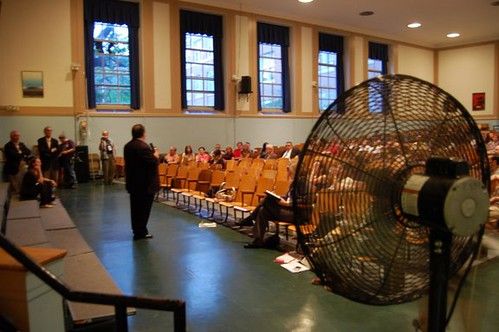Concerns Expressed at Brooklyn Dreams Hearing

(Photo by Daniel Cavanagh)
Last night’s hearing on the Brooklyn Dreams Charter School went much as expected: an unremarkable turnout of local and citywide charter opponents, with a smattering – an itsy, bitsy smattering – of advocates. To say the least, the opposition – though equally impassioned in their rhetoric – paled in comparison to the attendance at the Hebrew Language Academy hearing at Marine Park J.H.S.
The most compelling news of the night came from BDCS officials, who continued to reassure attendees that the school had no intention of seeking space carved from existing public schools. In fact, they informed, they’ve found a location at 269 Parkville Avenue (see map), near Ocean Parkway just north of Avenue H. One of the schools representatives added, “We are not looking to move into a public school. I don’t even believe in that. I think that’s wrong.”
In the stifling heat of the Shell Bank J.H.S. auditorium, the news did little to soothe opponents, who early on were reminded by SUNY Charter School Institute officials that the “final decision [on BDCS] rests with SUNY” and is not a direct result of the sentiments shared at the hearing.
And sentiments they did share. Opposition at the meeting was concentrated mainly on three points:
- District 22 is an exemplary district and so a charter school is superfluous
- Charters shave off good students and needed funds, thus threatening the district’s success
- BDCS, like other charters, is not a unionized school
On this last point it’s worth noting that a significant portion of the crowd was educators and members of the United Federation of Teachers (so much so, one attendee, undecided on the issue, told me he was angered at what he called a “union fest”). They called the school – and the charter system in general – anti-union. The only response by BDCS officials was to point out that they were not anti-union, they just weren’t unionized. “If we were required to be unionized than we would,” was the response of one official – take it for what it’s worth.
As to the first two points, BDCS officials and supporters argued primarily that this was about offering options. Performance-wise, district 22 is not in the doldroms. But the area is lacking options, particular the option of a different atmosphere and smaller class sizes.
Needless to say, such explanations did little for the audience. Faint murmers, boos and hisses rustled through the crowd.
Following the BDCS’s shoestring presentation – which notably lacked any sort of presentation – District 22’s Community Education Council (CEC) began interrogating and chiding BDCS officials for moving in on their territory. Christopher Spinelli, president of the CEC, and others from the group elicited cheers from the audience for laying into BDCS’s sales pitch regarding smaller class sizes. We all want smaller class sizes, he said, but charter’s are accomplishing that at the expense of the public school system.
Furthermore, district 22 “is a model for all of New York City, if not the nation,” he said. “If it ain’t broken, don’t fix it.” Cue cheers.
Others who spoke in this vein included State Assemblyman William Colton and Councilman Lew Fidler – who also spoke for Councilman Maisel. Fidler, with the fiery rhetoric of a politician in a reelection period, repeated much of what he told us last week. State Senator Golden sent a representative – a smart move, given that he was going on record as supporting BDCS. His rep quickly blurted into the microphone that Golden regretted not being able to attend and show his support. The four second statement sparked boos, but only after the audience got over their shock at the abruptness of it all.
The most excitement came when James Bernard, a board member at Excelsior, spoke. Excelsior is another charter school run by National Heritage Academies, and he is extremely satisfied with the organization. He has also helped BDCS officials navigate the system. Shouting from his seat in the auditorium (and receiving plenty of shouts right back), Bernard argued to SUNY officials that the meeting was not representative of the community’s sentiment. The school, afterall, had collected around 1,100 signatures from supportive residents. When I approached Bernard – and BDCS officials – afterwards, it was revealed that the signatures were collected over time by standing on street corners. BDCS reps explained the school to potential signees, leaving little room for opposition in an immensely complicated issue. Still, 1,100 signatures is no small thing.
In the end, as was said in the beginning, BDCS officials will make the decision. And given that the meeting was dominated by UFT members and not parents, it’s hard to say whether they’ll take the views expressed at the meeting to heart. Meanwhile, the school has supplied SUNY with 1,100 petitions from the community.
Based on last night’s meeting, I’d say we’ll be calling BDCS a neighbor pretty soon.




